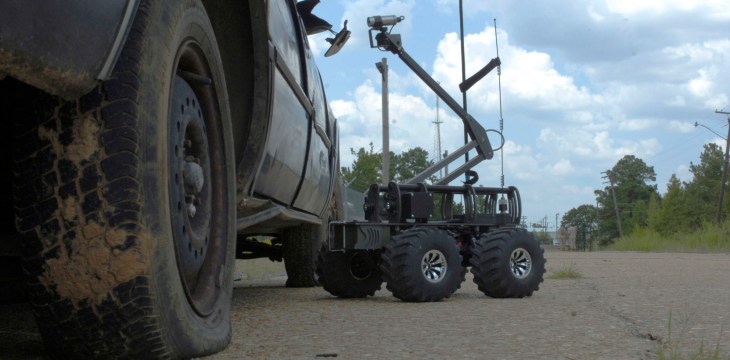The Dallas police force used a bomb-defusing robot equipped with an explosive device to kill a shooting suspect, police chief David Brown revealed today at a press conference. An explosive was affixed to the extension arm on the robot, Brown said at the press conference, in order to neutralize the suspect, later identified as Micah Xavier Johnson, 25. The incident involved the shooting of 12 officers, five of whom were killed, during a protest in Dallas organized in response to the recent police shootings of Philando Castile and Alton Sterling.
It does appear to be the first known example of a police department using an explosive in an offensive capacity to actually kill a suspect, but bomb-defusing robots have been weaponized in the past by police forces, in one instance resulting in a mobile home burning down.
Police have previously used bomb-squad robots to deploy non-lethal means of neutralizing suspects, as in the 2014 cause of Stephen Fought, a suspect suffering from schizophrenia who had secured himself inside a motel room and was refusing to come out. The Albuquerque police’s bomb squad in that instance was used to deploy “chemical munitions,” according to an official police department report at the time.
In the case mentioned above that resulted in the mobile home fire, police in Tennessee used a teargas grenade “dropped in the living room by a bot squad robot,” which was designed for outdoor use and which accidentally resulted in a fire that engulfed the entire trailer. The suspect was not at home, police later determined, so no injuries resulted from the incident.
Reports of armed robots being employed by law enforcement date back even further, however — a Wired report from 2007 details in-depth how robots originally designed for military use were being actively marketed and sold to domestic police forces in the U.S., including models that could be equipped with the following:
• Multi-shot TASER electronic control device with laser-dot aiming.
• Loudspeaker and audio receiver for negotiations.
• Night vision and thermal cameras.
• Choice of weapons for lethal or less-than-lethal responses
– 40 mm grenade launcher – 2 rounds
– 12-gage shotgun – 5 rounds
– FN303 less-lethal launcher – 15 rounds.
Those robots were not actually armed by the police departments which owned them, at the time of publication of that story, and those are different in purpose and construction from the robot likely used by the Dallas PD, which is likely a Marcbot-IV EOD, designed specifically for bomb defusion rather than offensive action. Similar robots have been used in an improvised manner similar to how Dallas police employed theirs in this situation in a few instances on the battlefield in combat situations.
Here’s a photo Dallas PD tweeted in 2012 of a public demonstration of their bomb-defusing robot:
Regardless of past examples of police robots used to deploy weapons, this incident seems unprecedented as it marks the first example in which the intent (or a likely potential outcome) was to end a human life.
